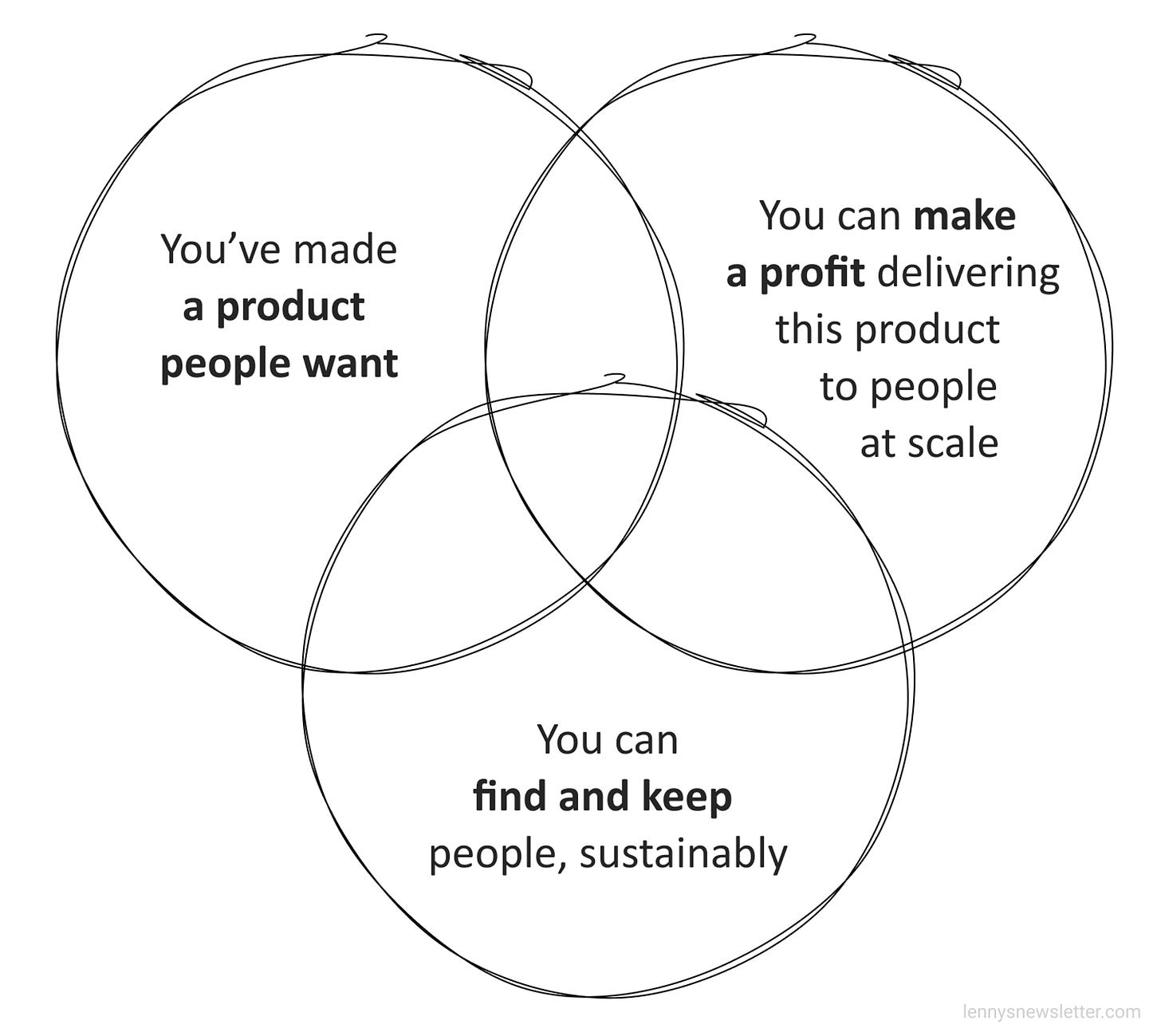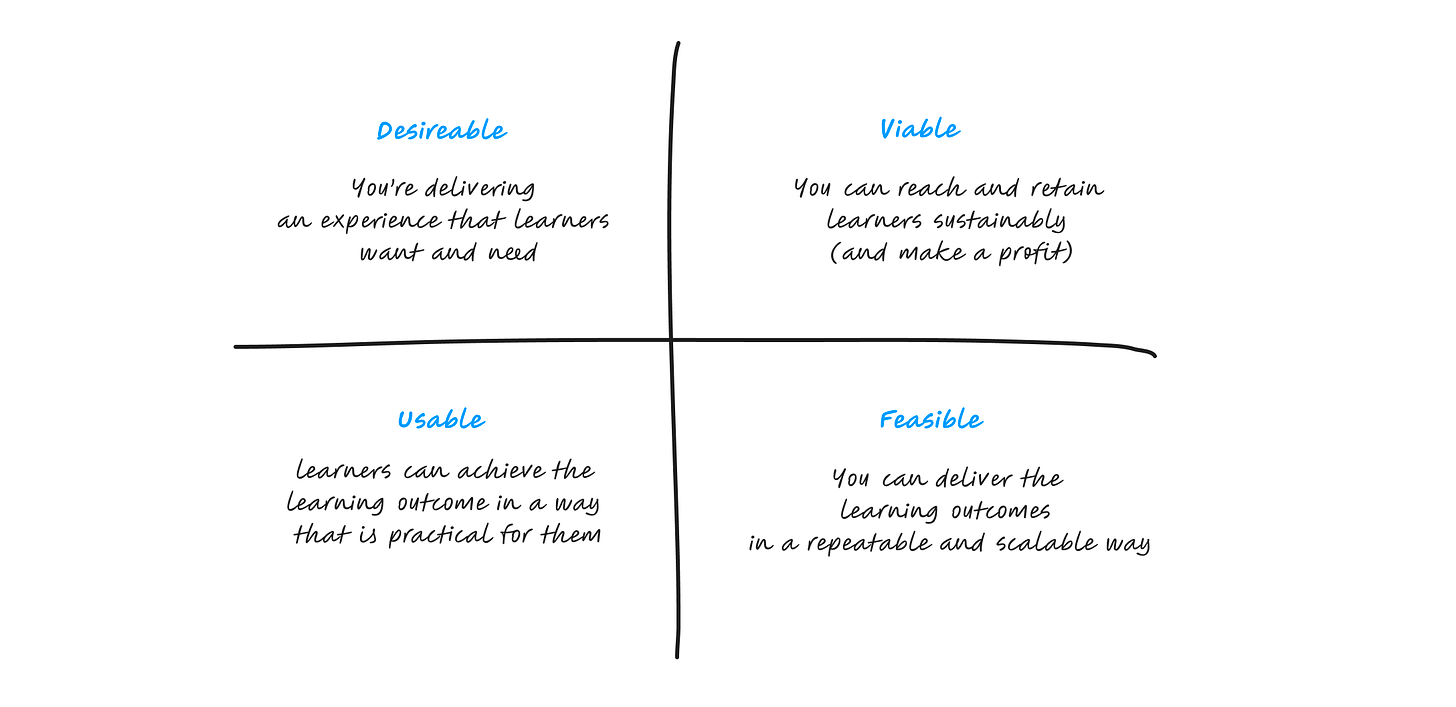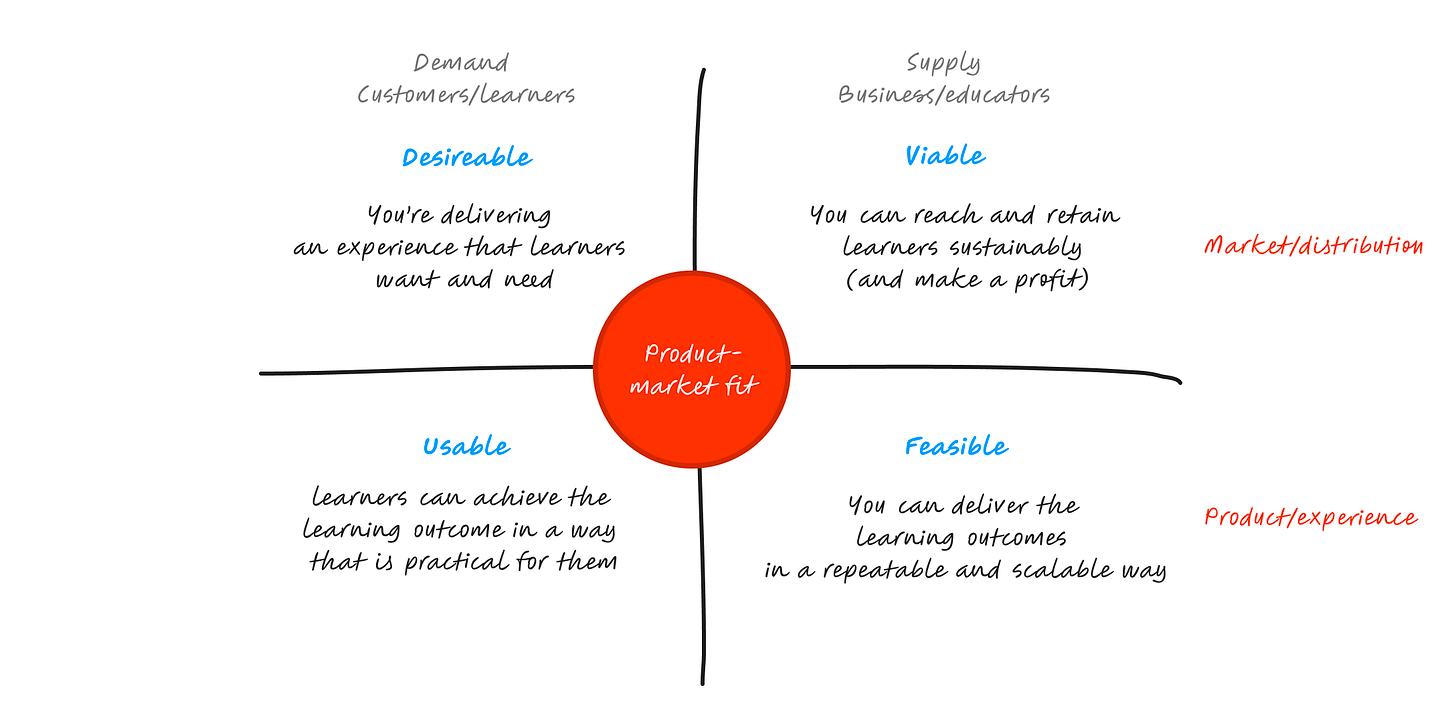What is product-market fit in learning?
How does the idea of product-market fit help us create successful learning experiences? Part two in my series on product thinking in learning.
🧩 This is part two of my series on product thinking for learning.
“Have you got product-market fit?”
If you work for a start up, this is the question that will regularly be asked.
Investors want to know this to understand if you’re worth investing in. Potential new team members want to know if your solving a problem people care about. You’re probably wondering yourself if this thing is going to work.
But it’s an equally useful concept if you’re still trying to find the magic or creating new things in a more established context.
Or if you have think you may have lost the magic. Product-market fit is not something you find once and then always have.
So, what exactly is product-market fit? And how is it a helpful concept when building new learning experiences?
Product-market fit in technology
The concept of Product-Market Fit was originally coined by Marc Andreessen in his essay The Only Thing That Matters. He described it — very broadly — as:
“Being in a good market with a product that can satisfy that market”.
By ‘market’, he means lots of people in a similar context, with the same motivation and desired outcome that have a similar willingness to pay.
He suggested that many people creating new products didn’t pay enough attention to the market and contested that the market always wins:
“In a great market — a market with lots of potential customers — the market pulls the product out of the startup… Conversely, in a terrible market, you can have the best product in the world and an absolutely killer team and it doesn’t matter — you’re going to fail.”
Many have built on his idea and added more nuance and sophistication.
Dan Olsen in the Lean Product Playbook described it as:
“Meeting the underserved needs of target customers better than the competition (or the alternative)”.
His book is all about how you go about identifying these unmet needs and finding the best solutions to meet them.
More recently Lenny of the influential Lenny’s Newsletter boiled it down to this helpful Venn diagram after canvasing the opinions of the many successful product operators in his network.
You’ve made a product that people want
You can a profit delivering this product to people at scale
You can find and keep people, sustainably
I find this last definition the most helpful because it starts to unpack it in a way that enables you to work out where to direct your efforts. It’s the one I refer to most in my Finding Product-Market Fit in EdTech programme.
Many people focus on “you’ve made a product people want”, with the key indicator of this being retaining users.
But the other two bubbles are equally as important if you want to create - and keep delivering - a viable and feasible experience.
Product-market fit = desirable, viable, feasible and usable
In my last article I talked about the Desirable, Viable, Feasible and Usable checklist as one way into product thinking.
I suggested that a product mindset involves keeping all four of these things in your head at once. I also proposed a specific definition for education:
You’re delivering an experience that learners want and need
You can reach and retain learners sustainably (and make a profit)
Learners can achieve the outcome in a way that is practical for them
You can deliver the learning outcomes in repeatable and scalable way
This definition is very similar to where Lenny arrived with his definition of product-market fit.
Lenny misses out ‘usable’. Interestingly, this is the one that Marty Cagan added to IDEO’s original DVF definition in Design Thinking. I’m with Marty and I think the solution being practical and usable is of equal importance.
Inspired by the musings of Tom Kerwin, I’ve plotted these qualities on to a two-by-two.
Here’s why I think it is helpful to visualise it in this way:
👆 The top two are all about the market or distribution side. Do people want and need the learning experience? And then can you reach and retain them in a way that is sustainable?
👇 The bottom two are all about the product or experience side. Have you made a usable and practical experience that is feasible to deliver in a repeatable and scaleable way?
👈 The lefthand side is all about the end users. In education, typically the learner (although sometime the educator). Or if we think about it as a ‘marketplace’, which many educational products are, the demand side. Is the experience something they desire and can they use it?
👉 The righthand side is about the business delivering it. In education, this is often the educators, in the broadest sense. Or in marketplace lingo, the supply side. Is the business viable and is it feasible to deliver the experience at scale?
This provides a helpful mental model to start to think about the challenge of finding product-market fit.
Why product-market fit is hard in edtech
Finding product market fit in education can be a tricky business. We can use this framework to start to unpack why.
Desirable
You’re delivering a learning experience people want and need.
Understanding the needs can be hard. Typically there is a learner. There is sometimes a parent in the mix. Often the experience might be mediated by a school, university or employer. Sometimes what they want is different from the learner. Understanding the dynamics here but not over complicating the fundamental desirability is key.
What a learner wants and needs can be different things. They are often hard to discover as they may not understand this themselves.
Educators want to teach people the thing they are passionate about. This means that they often forget to focus on what learners want and need and instead focus on delivering their passion is a way that is feasible.
Viable
You can reach and retain learners sustainably (and make a profit).
Learning is often not a constant, even if you believe it should be. It’s turned to in moments of transition and sudden need. This means that retaining a learner long enough to cover the acquisition costs need to be thought about carefully. Many edtech businesses have pivoted to B2B because of this challenge.
Often there are gatekeepers to learners and educators: schools, universities, employers, regulators… These organisation are often slow moving and complex to work with.
There can be weird expectations about value. Sometimes people expect things to be free (e.g. MOOCs). Other times they have an artificial price point (e.g. degrees).
Feasible
You can deliver the learning outcomes in a repeatable and scaleable way.
Human connections are often big part of the experience. Delivering great educational experiences is hard to do in a way that you can scale and repeat. Often this is the moment that you lose the magic. This is partly why there is a lot of excitement about generative AI.
The subject matter in some fields can be fast moving. This may require finding a model where content can be quickly updated.
Usable
Learners can achieve the outcomes in a way that is practical for them.
Learning takes time. Weeks, months, years even. There are long feedback loops and lagging indicators that make it hard to quickly iterate and improve the experience and to know whether that you have achieved the desired outcome.
Learning is also hard. People have to have a strong motivation to push on through being out of their comfort zone. This means that churn can be high for education products.
These are just a few of the many reasons finding product-market fit is hard. Education is a uniquely tough challenge to crack. But that where I believe product thinking can help frame, breakdown and tackle these problems.
This framework is designed to help provide a mental model to do that.
📝 Try working through each box. How confident do you feel about if your product is ticking the box?
Rate each out of five.
Write down as succinctly as you can what evidence you have for this.
Where are the areas that you need to focus?
💬 Is it a helpful thinking tool? Do get in touch and let me know.
🗓 Next time, I’m going to explore opportunities and solutions and add them to this map. Then the roles of individuals and cross-functional teams. And finally we’ll look at metrics. Then I’ll attempt to bring this framework together.
👉 If you’re interested in building the mindset, toolkit and network to tackle the challenge of finding product-market fit, I’m also recruiting for my next cohort. We start 13 March.







